Zoom
Trash

Scott Monument. The Scott Monument The Scott Monument is a Victorian Gothic monument to Scottish author Sir Walter Scott.
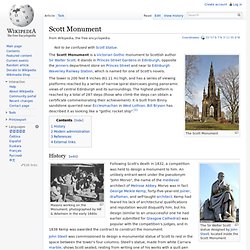
It stands in Princes Street Gardens in Edinburgh, opposite the Jenners department store on Princes Street and near to Edinburgh Waverley Railway Station, which is named for one of Scott's novels. The tower is 200 feet 6 inches (61.11 m) high, and has a series of viewing platforms reached by a series of narrow spiral staircases giving panoramic views of central Edinburgh and its surroundings. The highest platform is reached by a total of 287 steps (those who climb the steps can obtain a certificate commemorating their achievement). It is built from Binny sandstone quarried near Ecclesmachan in West Lothian. History[edit] Princes Street, Scott Monument Princes Street Gardens; Sir Walter Scott's MonumentDetails Details.
Alternative Names Princes Street Gardens; Sir Walter Scott's MonumentSite Type COMMEMORATIVE MONUMENTCanmore ID 74114Site Number NT27SE 481NGR NT 25585 73904Council EDINBURGH, CITY OFParish EDINBURGH (EDINBURGH, CITY OF)Former Region LOTHIANFormer District CITY OF EDINBURGHFormer County MIDLOTHIANDatum OSGB36 - NGR Canmore MappingView this site on a map Treasured Places - HLF funded Built between 1840-4, this monument commemorates Sir Walter Scott.
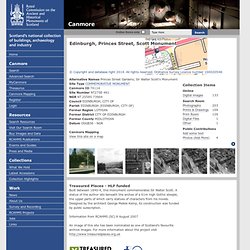
Buildings - Scott Monument - Description. Sir Walter Scott. Scott Monument - Edinburgh Memorial. Scott Monument Edinburgh Memorial to writer Sir Walter Scott – arguably Edinburgh’s most famous & favoured inhabitant Scott Monument Location: south side of Princes Street roughly opposite Jenners 1836-46 Architect: George Meikle Kemp (1795-1844) Scott Monument on left, Jenners on right: image © Adrian Welch.

Scott Monument. The soaring, Gothic monument to the memory of Sir Walter Scott (who died in 1832) was built in 1840-46 to a design by George Meikle Kemp, a self-taught architect.

In the competition to design the monument, Kemp came third but embellished his design to win (though professional architects were not amused). It was influenced by Melrose Abbey and nowadays looks more like a space rocket! The architect had met Scott in 1813 when the author, who was also the Sheriff of Selkirkshire, gave him a lift in his carriage.
Kemp entered the competition as "John Morvo" who was a medieval master mason at Melrose Abbey. But he never saw his ideas come to fruition - he tripped in a fog into the Union Canal in 1844 and drowned. Scott Monument - Edinburgh. Edinburgh Museums - Edinburgh Museums. Scott Monument. The Scott Monument - Edinburgh - Main Page. Here are my photographs of The Scott Monument in Edinburgh, it is a landmark Victorian Gothic structure in Princes Street Gardens.
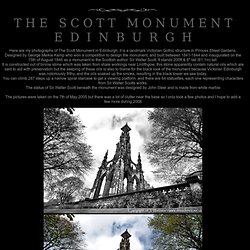
Designed by George Meikle Kemp who won a competition to design the monument, and built between 1841-1844 and inaugurated on the 15th of August 1846 as a monument to the Scottish author, Sir Walter Scott. It stands 200ft & 6" tall (61.1m) tall. It is constructed out of binnie stone which was taken from shale workings near Linlithgow, this stone apparently contain natural oils which are said to aid with preservation but the seeping of these oils is also to blame for the black look of the monument because Victorian Edinburgh was notoriously filthy, and the oils soaked up the smoke, resulting in the black tower we see today. You can climb 287 steps up a narrow spiral starcase to get a viewing platform. and there are 64 statuettes, each one representing characters from Sir Walter Scotts works. Scott Monument - Making of industrial and urban Scotland.
After Sir Walter Scott’s death in 1832, the Victorians decided to build a permanent monument to the famous Scots author in Princes Street Gardens in Edinburgh.
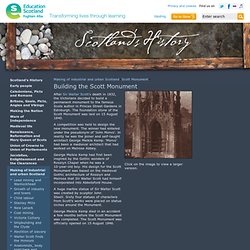
The foundation stone of the Scott Monument was laid on 15 August 1840. A competition was held to design the new monument. The winner had entered under the pseudonym of ‘John Morvo'. In reality he was the joiner and self-taught architect George Meikle Kemp. ‘Morvo’ had been a medieval architect that had worked on Melrose Abbey. The Scott Monument in Edinburgh. The Scott Monument sits in Princes Street Gardens in Edinburgh and is over 200 feet tall.
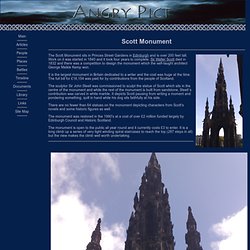
Work on it was started in 1840 and it took four years to complete. Sir Walter Scott died in 1832 and there was a competition to design the monument which the self-taught architect George Meikle Kemp won. It is the largest monument in Britain dedicated to a writer and the cost was huge at the time. The full bill for £16,154 was paid for by contributions from the people of Scotland. George Meikle Kemp. KEMP, GEORGE MEIKLE.

—This architect, whose great work, the Scott Monument, one of the noblest ornaments of Edinburgh, has secured the admiration of Europe, and the approbation of the highest judges of architectural excellence in every country, was the son of a lowly shepherd, who pursued his occupation on the southern slope of the Pentland Hills. Such a scenery, where nothing but nature predominated, in the form of bare brown mountains and dashing waterfalls, was the least of all adapted to create a perception of the beautiful in art; so that, had not Kemp been born an architect, he would probably have been to the end of his days a shepherd or a mechanic. But at the age of ten years, having been sent on a message to Roslin, only six miles distant, he then, and for the first time, beheld the creative power of man, in the remains of the ancient castle of Roslin, and above all, in its exquisite gem, the chapel. Mr. George Meikle Kemp. The Scott Monument, Edinburgh > EdinburghVideoGuide.com.
About The Scott Monument, the black, Gothic, rocket-like structure shooting up from Edinburgh’s Princes Street Gardens, commemorates Sir Walter Scott, one of Scotland’s most famous writers.

It was built in the mid 1800′s and it’s architect, George Meikle Kemp, drew inspiration from Roslin Chapel and Melrose Abbey when rendering his design. The Scott Monument in Edinburgh : The Gothic Rocket. It is unfortunate that many people around the world may not know who Sir Walter Scott was.
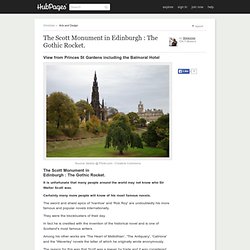
Certainly many more people will know of his most famous novels. The sword and shield epics of 'Ivanhoe' and 'Rob Roy' are undoubtedly his more famous and popular novels internationally. They were the blockbusters of their day. In fact he is credited with the invention of the historical novel and is one of Scotland's most famous writers. Among his other works are 'The Heart of Midlothian', 'The Antiquary', 'Catriona' and the 'Waverley' novels the latter of which he originally wrote anonymously. The reason for this was that Scott was a lawyer by trade and it was considered unseemly in late 18th century Scottish society for a man of such standing to indulge in mere story-telling. Not only was he a lawyer, a novelist as well as a poet, but he was also an advocate, a sheriff, a campaigner for the continued Union of Scotland and England as well as a great public figure.
Scott Monument, Edinburgh - Capital Collections. The Scott Monument, Edinburgh − Robert Adamson − A. Between 1843 and 1845 Hill and Adamson charted the progress made on the construction of the Scott Monument, seen here from the east end of Princes Street in Edinburgh. This calotype of the completed monument shows it without Sir John Steell’s sculpture of Sir Walter Scott, as this was still being carved from marble imported from Italy.
The first block was so heavy that it sank the ship. The second arrived in Leith in November 1844 and took twenty horses to drag it up the hill to the sculptor’s studio. When the monument was complete, reactions varied from disappointment to triumph and acclaim. The famous art critic John Ruskin called it ‘a small vulgar Gothic steeple’. Robert Adamson (Scottish, 1821 - 1848) Robert Adamson was one of the first professional photographers, setting up in business in Edinburgh in March 1843. David Octavius Hill (Scottish, 1802 - 1870) Jenners, Princes Street and Scott Monument, Edinburgh. Oblique aerial photograph taken facing west. The image toolbar Please note that you need to be registered and logged in to access certain features on the image toolbar.
Scott Monument on AboutBritain.com. Following the death of Sir Walter Scott on 21st september 1832 there was a widespread feeling in Edinburgh that a monument should be erected to his memory. The initial decision to proceed was taken at a public meeting on 5th October, and a competition was declared in order to select a design for the monument. The competition was won by George Miekle Kemp. Kemp was a working joiner who had attained recognition as an accomplished draughtsman, especially through his drawings of Melrose Abbey and Glasgow Cathederal.